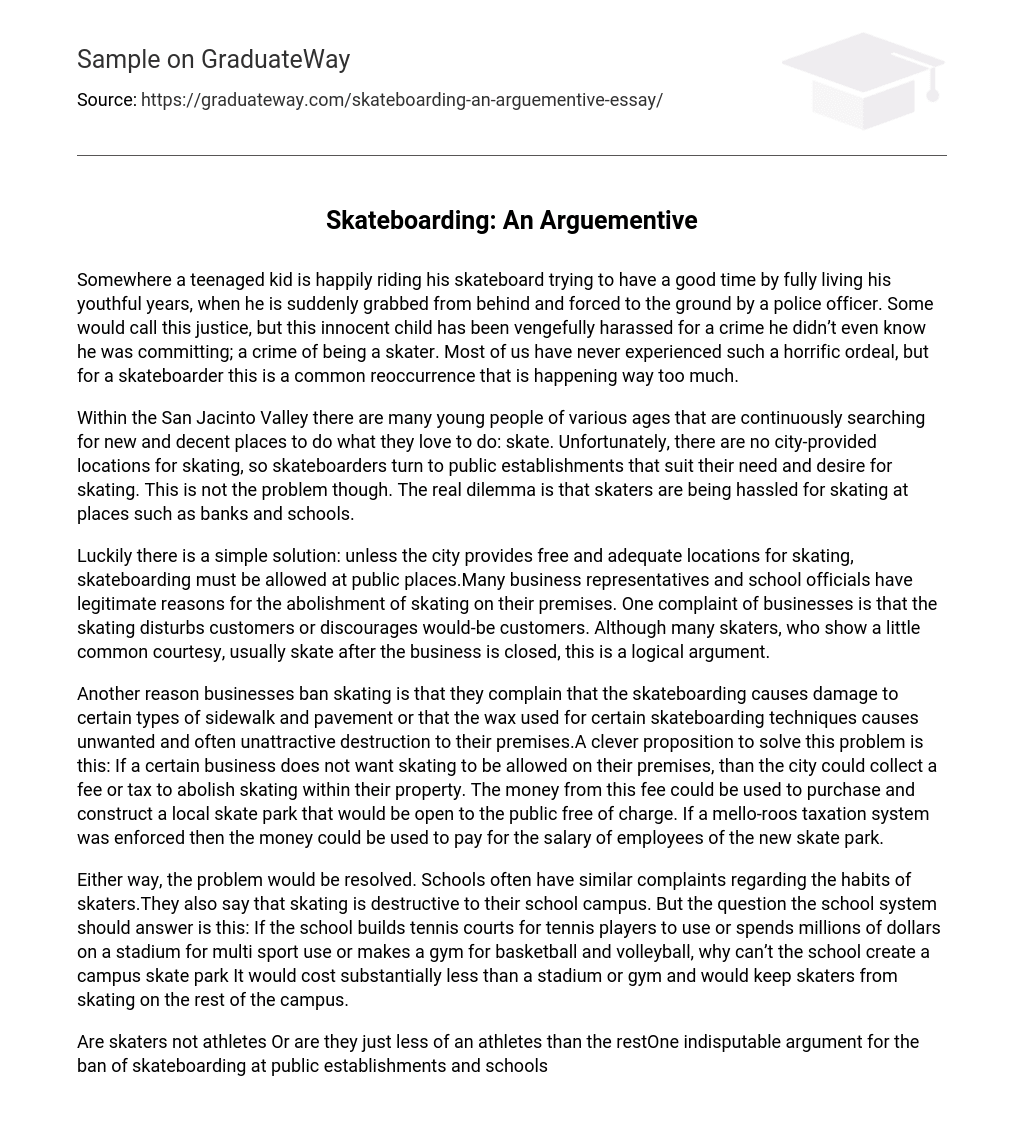Somewhere, a teenager is happily skateboarding, fully embracing their youth and seeking enjoyment. However, their peaceful moment gets abruptly disrupted as a police officer seizes them from behind and compels them to the ground. Some view this aggressive action as fair treatment, but in truth, the innocent skateboarder is being unjustly targeted for an offense they were unaware of committing – merely being a skater. While many of us have never encountered such a distressing encounter, for skateboarders, this is an unfortunately common incident that occurs too frequently.
Young people of various ages in the San Jacinto Valley are always on the lookout for new and appropriate places to indulge in their passion for skateboarding. Unfortunately, the city does not offer any official skateboarding spots, which compels skateboarders to utilize public establishments for their skating pursuits. Regrettably, skaters encounter harassment when they skateboard at locations such as banks and schools.
Luckily, there is a straightforward solution – if the city does not offer suitable and free skateboarding areas, then it is necessary to permit skateboarding in public spaces. Numerous business representatives and school officials have valid justifications for prohibiting skating on their properties. One concern raised by businesses is that skating disrupts or deters customers. While it is true that many skaters who exercise basic manners usually skate after business hours, this argument holds rationality.
Businesses often ban skating due to concerns about damage to sidewalks and pavement, as well as the unsightly destruction caused by skateboarding techniques that involve wax. One possible solution is for the city to impose a fee or tax on businesses that wish to prohibit skating on their property. The revenue generated from this fee could be used to build a free public skate park. To ensure sufficient funds, a mello-roos taxation system can be implemented to cover the salaries of the park’s employees.
Either way, the problem would be resolved. Schools often have similar complaints about skaters’ habits and their destructive impact on the school campus. However, the school system should question why they can build tennis courts, stadiums, and gyms for other sports but cannot create a skate park on campus. Such a skate park would be cost-efficient compared to a stadium or gym and would prevent skaters from using the rest of the campus as their skating ground.
The question remains: are skaters not athletes, or are they simply considered lesser athletes? One undeniable reason for the prohibition of skateboarding in public establishments and schools is the issue of liability. Local school faculty argue that if a skater injures themselves while skating on school premises, they could potentially sue the school. Since the school lacks an insurance plan for such incidents, it is only rational to enforce a ban on skating at schools. Despite these regulations, skaters continue to skate at schools and will likely continue doing so. However, if a skate center is built on campus or a local skate park is created, it can be assumed that illegal skating would decrease.
At present, the San Jacinto Valley only has one skate center. Although it is well-equipped, it proves to be costly for teenagers and children with limited financial resources. The price of a four-hour skating session is around six dollars. Hence, if a child receives a weekly allowance of ten dollars, the admission fee can be considered relatively high for them.
Currently, children must allocate more than half of their earnings to use the pay skate center for a limited four-hour duration. Consequently, they are left contemplating where else they can skate during the remaining time. Skateboarding is a recreational and physically engaging sport that parents should actively promote for their children. Despite its reputation for being rebellious or problematic, all kids truly aspire to improve their skills and achieve success in this delightful sport.
Skateboarding, similar to football or baseball, is considered a sport. It is important for parents and community leaders to support young athletes in their pursuit of this athletic activity. However, the concern arises when skateboarding is treated as a criminal offense. Professional Skateboarder Colin McKay criticized the strict measures enforced by law enforcement regarding skateboarding. He pointed out that the city spends a significant amount of money on daily police raids at skateboarding spots, resulting in wastage of resources. Despite this, skateboarders persistently continue skating in these areas regularly. When police officers arrive, they temporarily disperse but quickly resume their skateboarding activities.
The police arrive and we flee. Later, Colin McKay argues that instead of using tax money to pay the salaries of the police who incriminate skaters, it should be distributed to establish local skate centers. The San Jacinto Valley should seriously consider Colin’s perspective because if a toll-free, city-provided skating location is not provided, skateboarding will persist on public premises regardless of the repercussions.
According to Eric Hsu, police are creating animosity by treating skaters as criminals, which may result in an unforeseen change of direction.





